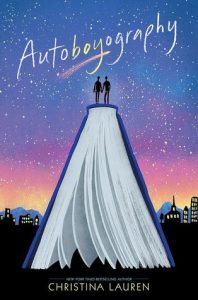Title: Autoboyography
Author: Christina Lauren
Publisher: Simon & Schuster BFYR
Genre: Love & romance, juvenile fiction
Year Published: 2017
Number of Pages: 404
Binding: hardback
ISBN13: 9781481481687
Price: $17.99 US
Reviewed by Rebekah Cuevas for the Association for Mormon Letters
Autoboyography affirms that love is risk, but queer love remains even riskier, especially in the profoundly religious setting of Provo, Utah. This book exposes the prejudices and dogma that drive people apart when their instincts and desires are to connect, all while offering a generous and earnest exploration of loyalty to self, family, and faith when all three seem unbearably at odds.
Tanner Scott is a high school senior who harbors zero confusion about who he is or what he wants. In this way, Tanner differs from many YA protagonists, but the narrative is by no means weakened by the fact that Tanner begins the story as a self-actualized agnostic bisexual in the midst of conservative Mormondom. Autoboyography is a coming-of-age story, but it’s not Tanner’s (which is ironic since it’s written as though by his own hand); it’s Sebastian’s, the thoroughly Mormon bishop’s son who Tanner falls in love with shortly after starting the Seminar–a creative writing class just for seniors in which Sebastian is a mentor.
Tanner’s attraction to Sebastian is as immediate as it is problematic, because Sebastian isn’t “out,” not even to himself. He has only ever identified as Mormon and struggles to imagine himself as anything (or anyone) else, especially someone whose essential identity challenges the faith that he loves.
It would be easy to vilify Mormonism as the story’s definitive antagonist, but Christina Lauren leaves it up to Tanner’s perspective as a cautious Provo newcomer to unveil the quirks, jargon, doctrine, policies, home décor, and even the ubiquitous cheerfulness that make up the esoteric community of Mormonism, and he is shrewd and fair-minded in his assessment. As a result, Autoboyography contributes vital insight to the discussion on sexual identity, conservative faith, and acceptance without being overtly polarizing, which makes it accessible.
The book is not an attack on faith; rather, it is a rallying cry for individuality. Sebastian doesn’t have to abandon his faith to be happy, even if he eventually puts aside the structure of it that has no place for him. His belief and trust in a god hold fast even to the end.
I enjoyed this book from cover to cover. Coded in its pages are lessons for queer and non-queer folk alike: lessons on consent, bi-visibility, homophobia (internalized and otherwise), and empathy. If I have any criticism to offer, it would be that Autumn’s character at the beginning is slightly erratic and Disney-channel-esque in her theatrical bursts of emotions: “‘Maybe you can add the Seminar.’ Autumn claps joyfully. Her eyes are flashlights, beaming their thrill into the dusky room…”
Much is described in the superlative, which I suppose can be standard for YA, but it can get tedious. Also, Autumn’s insistence that Tanner join the Seminar and then sudden displeasure when he does don’t jibe particularly well either. For me, it gave the impression that her character was still fleshing out, but by page 19 I was convinced that both Autumn and her relationship with Tanner had originality and dimension.
There are truly wonderful passages and descriptions as well and, overall, I really enjoyed the creativity and impact of the writing. I would absolutely recommend this book to my queer and Mormon friends and family.

